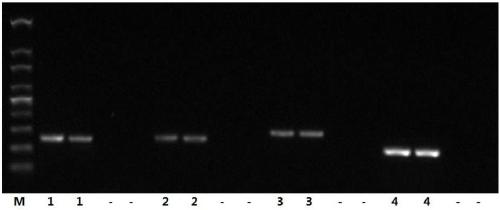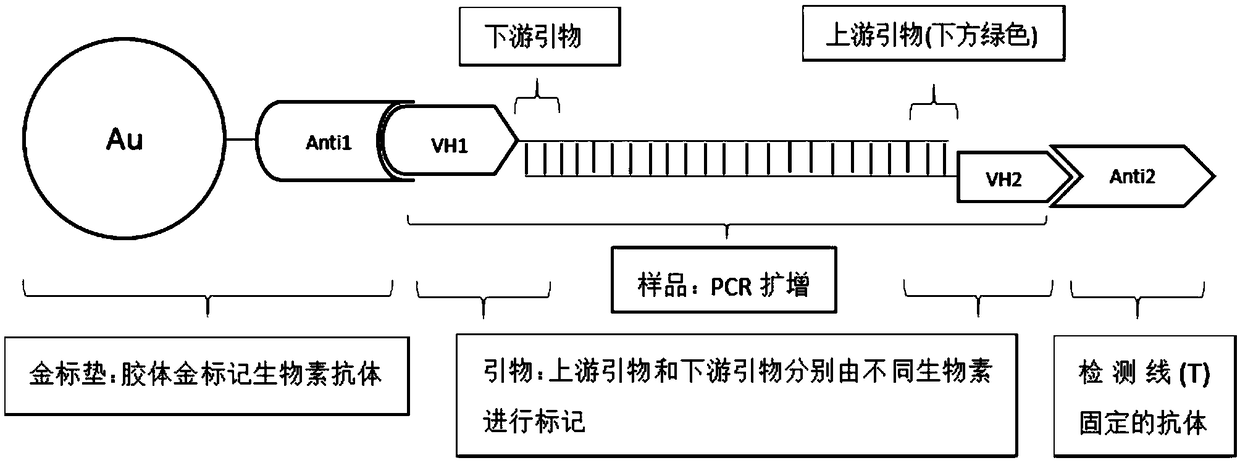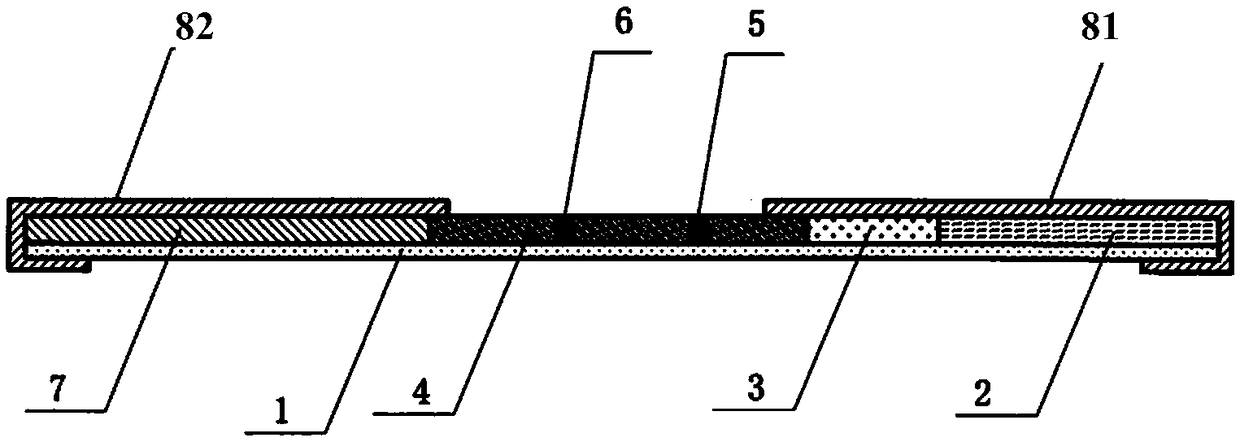Primer for detecting FHV-1, nucleic acid capture gold-labeled test strip, reagent kit and application
A FHV-1, nucleic acid capture technology, applied in the field of molecular biology, can solve the problems of high operator requirements, large instrument cost investment, low sensitivity, etc., and achieve improved detection sensitivity, high amplification efficiency and specificity, and high sensitivity. Effect
- Summary
- Abstract
- Description
- Claims
- Application Information
AI Technical Summary
Problems solved by technology
Method used
Image
Examples
Embodiment 1
[0104] Embodiment 1 is used for carrying out the primer design of PCR to FHV-1
[0105] Referring to the FHV-1 genome sequence included in GenBank, select the conserved region of the gC gene of FHV-1, and use ABIPrimerExpress 3.0 PCR primer design software to design and synthesize primers.
[0106] The typical primer pair sequences are as follows:
[0107]
[0108]
[0109] like figure 1 As shown, the four pairs of primers designed for FHV-1 virus were used for PCR amplification experiments, and the electrophoresis results showed that the primer amplification efficiency of FHV / gC210 was the highest, so this experiment used FHV / gC210-F and FHV / gC210- R is used as the detection sequence of FHV-1 virus, and its sequences are shown in SEQ ID NO.15 and SEQ ID NO.16 respectively.
[0110] in figure 2 The amplified fragment band numbered 1 is the PCR amplification product of the primer pair FHV / gC244; figure 2 The amplified fragment band numbered 2 is the PCR amplificatio...
Embodiment 2
[0111] Embodiment 2 PCR experiment
[0112] 1. Magnetic bead method for nucleic acid extraction
[0113] 1.1 Sample processing
[0114] Take pet feces or nasal secretion samples in 1mL normal saline or 1×PBS (0.01M, pH7.2) to prepare homogenate. Centrifuge at 2000rpm for 10min, and transfer the supernatant to a new centrifuge tube.
[0115] 1.2 Nucleic acid preparation
[0116] 1.2.1 After mixing the sample liquid evenly under sterile conditions, take 300 μL of the sample into a 1.5 mL clean centrifuge tube, add 500 μL of lysate and 10 μL of proteinase K, and bathe in water at 56°C for 30 minutes.
[0117] 1.2.2 The magnetic beads must be incubated at 37°C for 10 minutes before use, and shake gently by hand to make them appear in a suspended state.
[0118] 1.2.3 Add 15 μL of heated and mixed magnetic beads to the sample that has been lysed in a water bath, then add 250 μL of binding solution, and vortex to mix.
[0119] 1.2.4 Rotate the centrifuge tube in a mixer for 10 ...
Embodiment 3
[0137] Embodiment 3, colloidal gold standard test paper strip making
[0138] 3.1 Goldmaking
[0139] 3.1.1 Add 1ml of chloroauric acid (5g / L) to a clean Erlenmeyer flask equipped with a magnetic stirring bar, dilute it to 50ml with ultrapure water, and seal it with plastic wrap.
[0140] 3.1.2 Put the Erlenmeyer flask on the magnetic stirrer, turn on the stirrer, adjust the position of the Erlenmeyer flask so that the stirring bar is in the middle of the Erlenmeyer flask, and slowly increase the stirring speed to 1300±20r / min to ensure magnetic stirring After the child is stirring stably in the center of the Erlenmeyer flask, turn off the stirrer, stop stirring, adjust the heating knob to the maximum, and start heating.
[0141] 3.1.3 When the liquid in the bottle starts to boil, turn on the stirrer and quickly add 1000 μL of trisodium citrate solution (1%) into the bottle at the same time.
[0142] 3.1.4 Continue heating and stirring. After the color of the liquid graduall...
PUM
 Login to View More
Login to View More Abstract
Description
Claims
Application Information
 Login to View More
Login to View More - R&D
- Intellectual Property
- Life Sciences
- Materials
- Tech Scout
- Unparalleled Data Quality
- Higher Quality Content
- 60% Fewer Hallucinations
Browse by: Latest US Patents, China's latest patents, Technical Efficacy Thesaurus, Application Domain, Technology Topic, Popular Technical Reports.
© 2025 PatSnap. All rights reserved.Legal|Privacy policy|Modern Slavery Act Transparency Statement|Sitemap|About US| Contact US: help@patsnap.com



